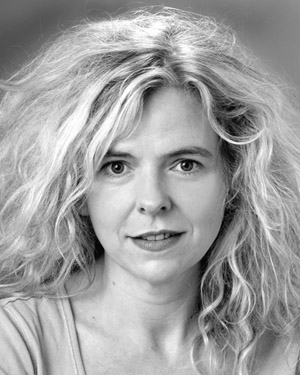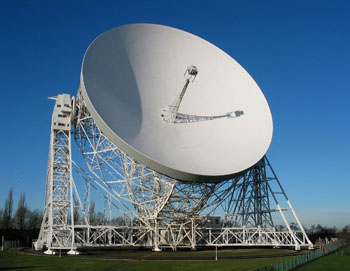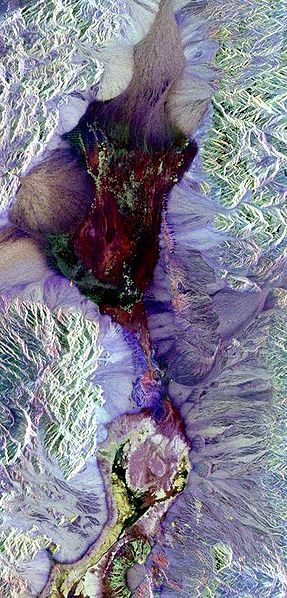Career interview: Actor and mathematician
A version of this interview is available as a podcast.
Victoria Gould has led unusual parallel careers: not only has she been a successful actor, she is also a mathematician, working first as a researcher and now as a teacher and communicator of maths. Recently she helped develop theatre company Complicite's production 'A disappearing number', which perfectly brought together the mathematical and theatrical sides of her life. We talk to Victoria about her life in mathematics, and her life in theatre, and how the two work together.

Victoria Gould
"I've always known that I wanted to be an actor, and I've always loved maths," says Victoria. "I felt like I had two brains!" But when Victoria was a teenager it didn't seem possible to pursue both mathematics and acting. "At school I was quite pushed into the arts, and used to secretly go into book shops and read maths books when I should have been studying A level arts subjects. It felt a bit like a guilty secret, that I was so interested in maths and that I found it rather comforting."
When Victoria left school she formed a small theatre company with four other friends, called the Kangaroo Club. "It was in the early eighties and there was quite a lot of public money around for arts projects." They toured a play around London, and then advertised for more members. The company, then a group of around 15 actors, devised a completely original show. It was based on their own experiences of going to clubs that were part of the New Romantic movement in the early eighties, and they performed the show in the clubs themselves. "So we were part of that Steve Strange kind of scene. [The show] was hugely successful and it was great fun. We even managed to pay ourselves a little bit." There are some similarities between this early project, and her most recent work with Complicite. "Looking at the work I do with Complicite, it's interesting that I was into devised theatre at such an early point in my career."
But even while running the Kangaroo Club, Victoria continued her secret reading of maths, "in a furtive way!". Many of us can relate to the thrill she felt from solving an equation or understanding a proof. But there was a deeper attraction. "I love the assurance of maths, I find it tremendously comforting, reassuring. I love the patterns and I love the consistency. I read a fantastic description of mathematics while researching the play [A disappearing number], which was that the mathematical definition of maths is it's the set of all possible self-consistent structures."
Acting gave Victoria confidence, and allowed her to express herself. "I love acting because I love telling stories, and I really enjoy pretending to be someone else! I think a lot of actors will tell you that. I think I'm essentially quite shy, which might be hard to believe, but if I'm pretending to be someone else, I find that very liberating and exciting." But the very nature of performing as a career had a negative side too. "The problem with being an actor, which any actor will tell you, is that you're always living on someone else's estimation of you. So you are always at the mercy of the last person who saw your work or gave you a job. Whereas in mathematics, the mathematics is there and it's always right, and it's always solid."

The Lovell telescope at Jodrell Bank. [Copyright Jodrell Bank Centre for Astrophysics, University of Manchester]
It was this aspect of acting, the feeling of having to constantly live in terms of other people's judgement of her, that made Victoria "come out as a mathematician". She completed her maths, physics and engineering A levels in a year, and went on to a degree in physics at the University of Manchester. Manchester, which had an excellent drama department, was the perfect place and Victoria finally had a chance to combine drama acting with science and maths. "I had this wonderful three years of being in the physics department in the day, being tutored by the Astronomer Royal, going to Jodrell Bank, doing great experiments. And then in the evening rehearsing plays. I think I did 10 plays in my first year at university!" And not only did her degree start her mathematical career, Victoria went on to work as an actor with many of the people she met in the drama department.
Victoria continued straight from her Bachelor of Science at Manchester to postgraduate study in maths. "I knew that I really ultimately wanted to act, but I didn't want to stop doing maths and physics. So I went and did a masters in applicable mathematics, at Cranfield," (then Cranfield Institute of Technology, now Cranfield University). The course involved a lot of linear algebra, applied computing including the concept of artificial intelligence, and signal processing. "It was slightly different from anything I'd done before, but it was extremely interesting." Her masters thesis was on the use of fractals in generating natural looking landscapes in computer imaging. (You can read more about using fractals to mimic nature in Modelling nature with fractals.)

Death valley as seen from the Space Shuttle's synthetic aperture radar instrument. This image is in false color; the surface color and intensity represent the radar reflection properties of the ground cover. The image is arranged like a map; the image pixels represent (approximately) rectangles on the ground. From JPL, NASA
The postgraduate degree led to a series of research positions, first working on sonar image processing at Marconi Maritime Applied Research Laboratory in Cambridge. This was during the early days of pattern recognition, and Victoria was working on techniques that would automatically spot wrecks on the sea bed. "I then went to King's College London, and worked in the physics department there on synthetic aperture radar, which I enjoyed a lot." This involved manipulating the signal received by an antenna mounted under an aircraft that is used to map the landscape below. "To increase resolution, to get a better picture, you need a larger aperture, which would soon need to be bigger than the actual plane, so you synthesise, or create the effect of a real aperture by applying some complex processes to the data from the single antenna. As the aircraft flies through space, you apply a complicated matrix of phase delays, and effectively focus the aperture mathematically as opposed to physically." Both research positions were essentially working in signal processing, using convolutions and the fast Fourier transform.
When Victoria had her first child, she took a break and moved to Brighton. She soon returned to maths research at the engineering department at Sussex University, looking at algorithms for weather modelling to integrate with something called the Battlefield Sensor Simulator (BSS), developed at RSRE Malvern. This involved lots of partial differential equations and fluid dynamics, and quite a lot of chaos theory. But she couldn't ignore the pull of acting forever.
"In the middle of that I was offered a part in Hamlet on the West End by someone I was at university with. I juggled the two for a little while, with the baby, doing research in the day and Hamlet in the evening in Covent Garden." Not surprisingly Victoria decided that this was too much, and she gave up the research to concentrate on acting again. A producer saw her performance in Hamlet, and she was asked to audition for the television show East Enders, leading to her playing the part of journalist Polly for two years. "I was catapulted into the weird world of soap land and infamy. People really believe that those soaps are real and people actually believed that I was Polly from East Enders."
After periods of intensive mathematics study and research, and acting in theatre, radio and television, Victoria has now reconciled her two parallel careers. "I now have quite a nice balance in my life. I have an agent and I act as much as I can. I do a great deal of theatre work and develop new writing. But I also do some supply teaching of mathematics, and I read as much maths as I can. And I also help children one-to-one with their maths, which I hugely enjoy. I recently have been involved with this fantastic project with Complicite, which has really brought the two halves of my life together, because we were looking at some really quite rigorous mathematical ideas to make a play. Which was absolutely fantastic and really exciting."
The play was inspired by the collaboration of the English mathematician, G. H. Hardy, and the Indian mathematician Srinivasa Ramanujan. "It's a very beautiful story about Ramanujan coming to Cambridge and collaborating with Hardy. And that was really the kernel of the play that Simon [McBurney - the director of Complicite] wanted to make." But the show is set in the modern world, and tells a number of stories, including conveying an impressive amount of mathematics onstage. "What we really didn't want to do was an exposition on maths. We wanted to somehow embody the maths in the show, within the music and the rhythm and the space of the show. We wanted it to be a mathematical experience as well as a theatrical one."
The result is a show that not only conveys a very human side to mathematics, including portraying mathematicians as noble, romantic heroes, but also explores complex mathematical themes in an imaginative way, and even uses maths as a metaphor for the human condition. (You can read more about the show in our review in this issue...)
As a result of the show, and continuing work she began as a maths teacher, she has been developing and taking maths and drama workshops with groups of people of all ages, from groups of adult maths and drama teachers, to A level students in England and India, and primary school students. "We've been looking at ways in which a group of people can collaborate together, in the same way a theatre company does, to explore mathematical themes, physically and emotionally."
The workshops involve a standard theatrical technique which uses "provocations" to spark creativity, but in these workshops the provocations used are mathematical. "Some are quite counter-intuitive, such as the irrationality of root two, while some are very simple, such as the ideas of multiples and factors." The group then explores these mathematical themes using the fact that the group is able to think, devise and move, either as a whole or each person independently.
"We might used something like partitions to choreograph a piece of theatre. We would introduce the group to the idea of partitioning a number into the additive sum of its components, and we might look at the partitions of two, then three, then four." They are then asked to physically embody the partitions of five, exploring how many there are, and show them in terms of physical bodies, perhaps showing how you can partition five people. "Then we might ask them to create a simple narrative, usually either in a restaurant or on a train, which actually tells a story, but where you have to be able to see all the partitions of five. And I'm quite rigorous, and say I'm looking for them all and we've got to see them all."
Not only does this exercise help convey mathematical ideas, it also has the benefit of making acting less daunting. "You have very quickly produced a scene, where, if you didn't know you were looking for the partitions of five you wouldn't know they were there. It is a lovely way of helping people to get the idea of performing out of their heads, of having to instantly create a fantastic character, and instead using the maths as a way of focusing and being in the space."
Even the simplest of mathematical concepts, such as shapes that are defined by incredibly simple rules, can create theatrical experiences. "Once, when supply teaching, I was asked with no notice to run a Maths and Drama workshop with some 'challenging' children. In a panic I threw my keys into the centre of the studio space, and said I'd like everyone to enter the room in silence and sit down so they are all in equal distance from the keys." Victoria used this idea to introduce loci and circles. "And we do another one which is marvellous for movement. Everyone in the room secretly chooses two other people, but doesn't let them know who they are. And when I say, make yourself into an equilateral triangle with those two people, of course it creates this fantastically chaotic movement because people don't know who the other people are, and it's a great way of creating a very natural looking dynamic movement. It's another example of an incredibly simple rule creating very chaotic behaviour which is analogous to the weather, and movement of the solar system, and fractals."
Choosing maths over acting, or acting over maths is not an option for Victoria. "There have been various times in my life when I've done one without the other, and it doesn't work. My brain needs to be doing both. I've been incredibly lucky to not only be able to pursue both of these things, but also to bring them together in the work that I've done recently."
In fact she uses many of the same skills in each job. "I think they both are very much informed and helped by each other. I think teaching is a performing job and a lot of the techniques for teaching a large class are very rooted in theatrical training, like the idea of stillness being more powerful than a lot of chaotic movement, that expecting good behaviour, by one's own calmness, is much more powerful in terms of discipline in the classroom. And I do find that I approach making theatre in a very mathematical way. I have to plan quite carefully what I do."

A scene from 'A Disappearing Number' [Copyright Robbie Jack]
The process of devising the show with Complicite was in some ways reminiscent of mathematical research. The process involved a long period of exploring the mathematical and personal concepts that inspired the play. On and off for two years, Victoria and the rest of the company worked in a large rehearsal room with a huge variety of resources, such as sound designers, visual artists, musicians, dancers, mathematicians, costumes and props. "We would talk about extraordinary things. We would spend a whole day talking about the difference of two squares, and physicalising that." And out of the weeks and months of playing with ideas, not only did they create "huge amounts of complete dross", but also moments of beauty, and it was these that were brought together to create the play.
"You get an enormous amount of rubbish, but when something is really right, and beautiful, you know. And I know that Simon, when he makes theatre, he is looking for that moment when all the audience will come together, in terms of them having the same image in their heads, or the same sense of being in the room together."
"For me that is very analogous to the way that mathematicians work. Quite a lot of the time you're doing stuff that isn't going to work, that is rubbish. But when something is right you do know. And for me it's about that idea of self-consistency, that when something is right, there is a consensus that it is right. And when a piece of theatre is beautiful there's a consensus in the audience, you can feel it in the air. That is why I prefer theatre to film because everyone is breathing the same air, and that sense of coming together and rightness."
There is an almost universal acknowledgement of beauty, whether in theatre or maths, and this can bring people together. "Everybody likes the same things, everybody likes the same stories. And I feel that about maths. I think it is something that brings people together, it's something we have in common, in the same way that a piece of theatre brings people together."
And just as it did when she was at school, maths still brings Victoria relief and reassurance. "When teaching or acting becomes stressful, I retreat to maths a lot for it's calmness and its patterns. I'll quite often, in a stressful time, go off and do a bit of linear algebra or some trigonometric identities. They're hugely calming for me." Maths as stress relief? "Absolutely, it works every time!"
A version of this interview is available as a podcast.
About the author
Rachel Thomas is Co-editor of Plus.